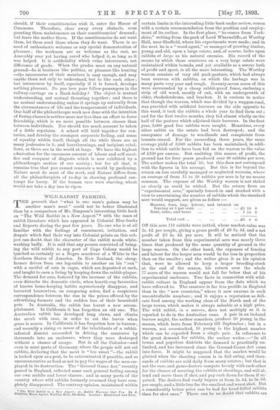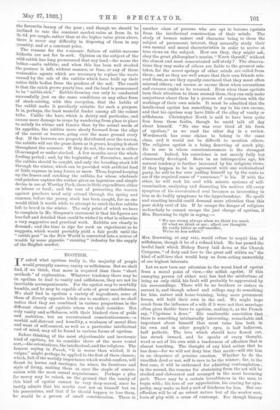WILD-RABBIT FARMING.
T"proverb that "what is one man's poison may be another man's meat" could not be better illustrated than by a comparison of Mr. Simpson's interesting little book on "The Wild Rabbit in a New Aspect"* with the mass of rabbit literature which has appeared in Colonial Blue-books and Reports during the past few years. No one who is at all familiar with the feelings of resentment, irritation, and despair which find their way into Colonial prints on this sub- ject can doubt that the character of the rabbit needs white- washing badly. It is said that any person convicted of bring- ing the wild rabbit to any port of Cape Colony would be lynched as certainly as a Negro murderer of a White in the Southern States of America. In New Zealand, the sheep- iarmer drives from one log-cabin to another on his "run" with a cartful of cats in cages, which are deposited at each, and taught to earn a living by keeping down the rabbit-plague. The demand for cats, fostered by the increase of the rabbits, even disturbs the domestic circle, when hearth-rug favourites of known home-keeping habits mysteriously disappear, and bereaved housewives, on comparing notes, find a suspicious correspondence between the rise hi the prices offered by the advertising farmers and the sudden loss of their household pets. In Australia, the rabbit has learnt a new accom- plishment. In California it has forgotten an old one. The Australian rabbit has developed long claws, and climbs the scrub with ease, in order to eat the leaves when grass is scarce. In California it has forgotten how to burrow; and recently a rising en masse of the inhabitants of a rabbit- infested district succeeded in driving the creatures by thousands into an enclosure, where they were destroyed without a chance of escape. But in all the Colonies—and even in most parts of Germany, where the people will not eat rabbits, declaring that the meat is "too sweet "—the rabbit is looked upon as a pest, to be exterminated if possible, and so unremunerative as food as not to pay the wages of the men em- ployed in its destruction. The "Ground Game Act," recently passed in England, reflected some such general feeling among our own middle and lower classes ; and in many parts of the country where wild rabbits formerly swarmed they have com- pletely disappeared. The contrary opinion, maintained within * The Wild Rabbit in a New Aoect ; or, Rabbit Warren, that Pay By j. Bhmr,coo, Wood Agent, Wortley Hall, Sheffield, London : Blackwood And Sons. certain limits in the interesting little book under review, comes with a certain recommendation from the position and employs ment of its author. In the first place, "he comes from York- shire," writing from the park of Lord Wharncliffe, at Wortley Hall, near Sheffield, where his experiments were made ; and in the next he is a "wood agent," or manager of growing timber, young and old, upon a large estate, and, of course, looks upon rabbits at large as his natural enemies. His record of the means by which these creatures on a very large estate were maintained within bounds, and yet available as a source both of profit and sport, is all the more interesting. The Wortley warren consists of very old park-pasture, which had always been overrun with rabbits, on which the herbage was in many parts very poor and rough. Seventy-seven acres of this were surrounded by a cheap rabbit-proof fence, enclosing a strip of old wood, mostly of oak, with an undergrowth of elder, rhododendrons, and bracken. It is curious to notice that though the warren, which was divided by a waggon-road, was provided with artificial burrows on the side opposite to this wood, it took the rabbits a whole year to find them out ; and for the first twelve months, they fed almost wholly on the half of the pasture which adjoined their burrows. In the first year, 3,000 good live rabbits were caught. Meantime, every other rabbit on the estate had been destroyed; and the annoyance of damage to woodlands and complaints from tenants ceased. For the succeeding three years, the same average yield of 3,000 rabbits has been maintained, in addi- tion to which cattle have been fed on the warren to the value of £100 per annum. But omitting this source of profit, the ground has for four years produced over 40 rabbits per acre. The author makes the total 50; but thhedoes not correspond with the figures in his acreage. But this is far beyond the return on less carefully managed or neglected warrens, where an average of from 15 to 20 rabbits per acre is by no means common. The expense of the Wortley warren is not stated as clearly as could be wished. But the return from an "experimental acre," _specially fenced-in and stocked with a view to ascertaining the number of rabbits which the standard acre would support, are given as follow :— Manure, lime hay, labour, and interest on
fencing at d per cent. ...
Rent, rates, and taxes ...
Total cost ... •.. £1
1 10 00 14
.23 4 0
Off this acre 110 rabbits were netted, whose market-value was 2s. 46. per couple, giving a gross profit of £6 Ss. 4d. and a net profit of £3 4s. 46. per acre. It will be noticed that the number taken from this experimental acre was nearly three times that produced by the same quantity of ground in the large warren. On the other hand, the expenses of fencing and labour for the larger area would be far less in proportion than on the smaller ; and the writer gives it as his opinion that, were he allowed to keep a larger breeding-stock at the end of the season, his return over the whole 77 acres of the warren would not fall far below that of his experimental enclosure. Two facts in connection with wild. rabbit culture in England appear from the data which we have referred to. The creature is far less prolific in England than in the "new countries," where it now swarms in such uncontrollable numbers ; and it enjoys a reputation as deli- cate food among the working class of the North and of the large towns, which makes it always saleable at a high price. The wild rabbit, in a warren, does not multiply as it is reported to do in the Australian runs. A pair in an isolated burrow might, the author considers, produce 20 young in the season, which lasts from February till September ; but in a warren, not overstocked, 10 young is the highest number which can be expected from a single pair. In reference to the great demand for rabbits, the author writes :—"In all towns and populous districts the demand is practically un- limited, and has increased since the Ground-Game Act came into force. It might be supposed that the market would be glutted when the shooting season is in full swing, and thou- sands of rabbits are sold daily from many estates ; but that is not the case, and game-dealers compete keenly with each other for the chance of securing the rabbits at shootings, and will at- tend and move them if shot, and pay cash down for them if re- quired. The dealers find ready buyers at from 2s. 6d. to 3s. 66. per couple, and a little less for the smallest and worst shot. But a considerably better price can be had for hand-lulled rabbits than for shot ones." There can be no doubt that rabbits are the favourite luxury of the poor ; and though we should be inclined to rate the constant market-value at from 2s. to .2s, 6d. per couple, rather than at the higher value given above, there is never any difficulty in disposing of them in any -quantity, and at a constant price. The reasons for the e3onomic failure of rabbit-warrens -hitherto are not far to seek. Opinion on the subject of the wild-rabbit has long pronounced that any land—the worse the better—suits rabbits; and when this has been well stocked the pasture is left, without manure, or lime, or any of those restorative agents which are necessary to replace the waste -caused by the sale of the rabbits which have built up their aotive little bodies from the produce of the soil. The result is that the catch grows yearly less, and the land is pronounced to be rabbit-sick." Rabbit-farming can only be conducted -successfully just on the same conditions as any other form of stock-raising, with this exception, that the habits of the rabbit make it peculiarly suitable for such a purpose. It is, perhaps, the least wasteful feeder among all the rodent tribe. Unlike the hare, which is dainty and particular, and -causes more damage to crops by wandering from place to place to satisfy its whims and fancies than by the actual needs of its appetite, the rabbits move slowly forward from the edge -of the covert or burrow, going over the same ground every -day. If the burrows are properly distributed over the warren, the rabbits will eat the grass down as it grows, keeping it short throughout the summer. If they do not, the warren is either ill-arranged or under-stocked. A few months cover the whole feeding period ; and, by the beginning of November, most of the rabbits should be caught, and only the breeding-stock left through the winter, which can be provided with artificial food at little expense in long frosts or snow. Thus, beyond keeping up the fences and catching the rabbits, for whose wholesale and painless capture the author gives an ingenious and simple device in use at Wortley Park, there is little expenditure either on labour or food ; and the cost of protecting the warren against poachers need only extend through the spring and -summer, before the young stock has been caught, for no one would think it worth while to attempt to catch the few rabbits left to breed in the winter. The only point of which we have to complain in Mr. Simpson's statement is that his figures are less full and detailed than could be wished in what is otherwise a very suggestive and practical work. Rabbits are clearly in demand ; and the time is ripe for such an experiment as he suggests, which would probably yield a fair prat until the ." rabbit pest" in the New World is converted into a source of wealth by some gigantic " canning " industry for the supply of the English market.



































 Previous page
Previous page